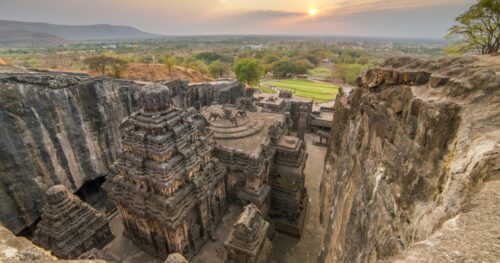Rashtrakutas: Lords Of The Deccan | Part 2

In the first part we had seen the rise of the powerful Chalukyas. We had also been introduced to Danti Durga Rashtrakuta, who would later initiate their downfall. The second part takes us forward into this period of medieval India, vividly narrating the rise of the mighty Rashtrakutas.
Studying History is one roller coaster of a ride. Rise of dynasties, shift of power from one emperor to another, an unfathomable downfall, and rising yet again from the dust. With the might and power of the daring Chalukyas, who would have imagined them to be outplayed? And yet, in this part of the book, we shall see how the ferocious Rashtrakutas virtually dwarf their predecessors.
What You Get In This Part
This part of Lords Of The Deccan will introduce you to the prominent Rashtrakuta rulers, viz.: Danti Durga, Krishna, Govinda and Dhruva Rashtrakuta. It highlights their major conquests ranging from Ujjain to the Latas, Vatapi, Pratiharas, Pallas and Gangas. The Elephant warfare of Danti Durga being a distinct feature of this dynasty.
The book also talks about valedictory rituals such as Hiranyagarbha or Digvijaya that the Rashtrakuta emperors performed. As with the Chalukyas, architecture finds a prominent place in the Rashtrakuta clan, used primarily as a symbol of their power and control. It is this aspect I wish to elaborate further.
Architectural Marvels Of The Rashtrakutas
There are two prominent architectural works that stand out in this period. First, Danti Durga’s Dashavatara Temple dedicated to Lord Shiva. This is one of the largest standing temples of Asia till date.
But what presumably dwarfs every other architectural achievement is Krishna Rashtrakuta’s majestic Krishneshvara Temple. Known today as the Kaislasha Temple of Ellora or Cave 16, it is the largest monolithic temple in the world. You will find a vivid description of it by Anirudh Kanisetti in the book. It is a delight to read about the intricacies of this engineering masterpiece. The author laces it with fictionalized views of it’s construction and of the Rashtrakutas celebrating a festival at the temple.
Actually, I was pushed to search more about this marvel on the internet. And, I found this wonderful video of the Kailasha Temple. Watching it live simply leaves you spell bound. All credit to the uploader, you may watch it here:
The Longest Ruling Rashtrakuta
The last chapter in this section is dedicated to the Rashtrakuta emperor Amoghavarsha.
Amoghavarsha dominated the Deccan for over six decades, a feat no other monarch before or after him could challenge. This probably is the most engrossing portion of this section of the book. Born as Sarva Rashtrakuta, the life of this charming ruler is nothing short of a perfect Bollywood script. Honestly speaking, reading about Amoghavarsha’s life struck a chord within my heart. In place of being centered around war, his reign is dotted with emphasis on trade and intellect (poetry).
What Lies Ahead
The third and concluding part of Lords Of The Deccan shall talk about the Kalyana Chalukyas and the Chola Dynasty.
How To Best Read This Book
I would suggest you keep your phone or tablet handy reading this book. A quick Google search on an ancient city, monument or clan facilitates the understanding. I kept referring google for the rivers and cities being mentioned. And, to see them on the Indian map just made things so much clearer. A quick look at an ancient temple’s video (as above) or a little more on a dynasty being mentioned. This makes it all the more interesting.
Conclusion
Anirudh Kanisetti’s Lords Of The Deccan comes as a feast for Historical Fiction fans. This book is a mine of knowledge, specially for lovers of historical fiction. It is fascinating to read the lesser known facts of the people who lived and ruled our land centuries before us.
The good thing about this book is, it is majorly History, less fiction. And where it is fiction, the author has clearly mentioned so. In many previous historical fiction books from Indian authors, I found it impossible to guess facts from fiction. Thankfully, that is not the case here.
I would however say, the volume of details in the book may tend to get a little overwhelming. I would certainly like it if there was a brief point-wise summation of each chapter at it’s end. That said, this book is a prized possession! You can order your copy here.
More in Indian Historical Fiction The Vault Of Vishnu (Ashwin Sanghi)

Very interesting book I must say. So fascinating to read of the history and dynasties. Thanks for the writeup!